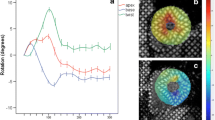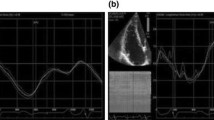Abstract
Training induces changes in cardiac structure and function which improves cardiac output (CO) and oxygen delivery during exercise. It is unclear whether it is cardiac structure or function which is of greatest importance in determining maximal oxygen consumption (VO2max). In 55 subjects (15 non-athletes, 32 amateur and 8 elite athletes), left and right ventricular (LV and RV) volumes and mass were assessed by magnetic resonance imaging (CMR). Comprehensive traditional and novel echocardiographic measures included colour-coded Doppler echocardiography to assess myocardial velocities, strain and strain rate at rest and maximal exercise in both ventricles. Measures of cardiac size and function were assessed as univariate and multivariate predictors of VO2max. LV and RV mass correlated strongly with VO2max (r = 0.79 and r = 0.65, respectively, p < 0.0001), as did LV and RV end-diastolic volumes (r = 0.68 and r = 0.75, p < 0.0001) and heart rate reserve (r = 0.60, p < 0.0001). Measures of myocardial function were not predictive of VO2max with the exception of RV diastolic velocities (r = 0.32 and r = 0.36 for rest and exercise, respectively, p < 0.05). On multivariate analysis, only RV end-diastolic volume, LV mass and heart rate reserve were independent predictors (beta = 0.28, 0.45 and 0.27 respectively, p < 0.0001) and together explained 73% of the variance in VO2max. Measures of cardiac morphology are strongly associated with VO2max in healthy adults and well-trained athletes. A combination of ventricular volume, mass and heart rate reserve explains much of the variance in VO2max, whilst measures of myocardial function do not further strengthen predictive models.


Similar content being viewed by others
References
Abergel E, Chatellier G, Hagege AA, Oblak A, Linhart A, Ducardonnet A, Menard J (2004) Serial left ventricular adaptations in world-class professional cyclists: implications for disease screening and follow-up. J Am Coll Cardiol 44:144–149
Bassett DR Jr, Howley ET (2000) Limiting factors for maximum oxygen uptake and determinants of endurance performance. Med Sci Sports Exerc 32:70–84
Bellenger NG, Davies LC, Francis JM, Coats AJ, Pennell DJ (2000) Reduction in sample size for studies of remodeling in heart failure by the use of cardiovascular magnetic resonance. J Cardiovasc Magn Reson 2:271–278
Carlsson L, Lind B, Laaksonen MS, Berglund B, Brodin LA, Holmberg HC (2011) Enhanced systolic myocardial function in elite endurance athletes during combined arm-and-leg exercise. Eur J Appl Physiol 111:905–913
Caso P, D’Andrea A, Galderisi M, Liccardo B, Severino S, de Simone L, Izzo A, D’Andrea L, Mininni N (2000) Pulsed Doppler tissue imaging in endurance athletes: relation between left ventricular preload and myocardial regional diastolic function. Am J Cardiol 85:1131–1136
Caso P, Galderisi M, D’Andrea A, di Maggio D, de Simone L, Martiniello AR, Mininni N, Calabro R, Sutherland GR (2002) Analysis by pulsed Doppler tissue imaging of ventricular interaction in long-distance competitive swimmers. Am J Cardiol 90:193–197
Chemla D, Castelain V, Humbert M, Hebert JL, Simonneau G, Lecarpentier Y, Herve P (2004) New formula for predicting mean pulmonary artery pressure using systolic pulmonary artery pressure. Chest 126:1313–1317
D’Andrea A, Caso P, Galderisi M, di Maggio D, Cicala S, D’Andrea L, Mininni N, Calabro R (2001) Assessment of myocardial response to physical exercise in endurance competitive athletes by pulsed doppler tissue imaging. Am J Cardiol 87:1226–1230 (A1228)
Devereux RB (1987) Detection of left ventricular hypertrophy by M-mode echocardiography. Anatomic validation, standardization, and comparison to other methods. Hypertension 9:II19–II26
Ekblom B, Hermansen L (1968) Cardiac output in athletes. J Appl Physiol 25:619–625
Grothues F, Smith GC, Moon JC, Bellenger NG, Collins P, Klein HU, Pennell DJ (2002) Comparison of interstudy reproducibility of cardiovascular magnetic resonance with two-dimensional echocardiography in normal subjects and in patients with heart failure or left ventricular hypertrophy. Am J Cardiol 90:29–34
Grothues F, Moon JC, Bellenger NG, Smith GS, Klein HU, Pennell DJ (2004) Interstudy reproducibility of right ventricular volumes, function, and mass with cardiovascular magnetic resonance. Am Heart J 147:218–223
Holland DJ, Sharman JE, Leano RL, Marwick TH (2009) Gender differences in systolic tissue velocity: role of left ventricular length. Eur J Echocardiogr 10:941–946
Kneffel Z, Horvath P, Petrekanits M, Nemeth H, Sido Z, Pavlik G (2007) Relationship between relative aerobic power and echocardiographic characteristics in male athletes. Echocardiography 24:901–910
Krieg A, Scharhag J, Kindermann W, Urhausen A (2007) Cardiac tissue Doppler imaging in sports medicine. Sports Med 37:15–30
La Gerche A, Taylor AJ, Prior DL (2009) Athlete’s heart: the potential for multimodality imaging to address the critical remaining questions. JACC Cardiovasc Imaging 2:350–363
la Gerche A, Heidbuchel H, Burns AT, Mooney DJ, Taylor AJ, Pfluger HB, Inder WJ, Macisaac AI, Prior DL (2011) Disproportionate exercise load and remodeling of the athlete’s right ventricle. Med Sci Sports Exerc 43:974–981
Levine BD (2008) VO2max: what do we know, and what do we still need to know? J physiol 586:25–34
Levine BD, Lane LD, Buckey JC, Friedman DB, Blomqvist CG (1991) Left ventricular pressure-volume and Frank–Starling relations in endurance athletes. Implications for orthostatic tolerance and exercise performance. Circulation 84:1016–1023
Longmore DB, Klipstein RH, Underwood SR, Firmin DN, Hounsfield GN, Watanabe M, Bland C, Fox K, Poole-Wilson PA, Rees RS et al (1985) Dimensional accuracy of magnetic resonance in studies of the heart. Lancet 1:1360–1362
Nottin S, Doucende G, Schuster-Beck I, Dauzat M, Obert P (2008) Alteration in left ventricular normal and shear strains evaluated by 2D-strain echocardiography in the athlete’s heart. J Physiol 586:4721–4733
Oxborough D, Batterham AM, Shave R, Artis N, Birch KM, Whyte G, Ainslie PN, George KP (2009) Interpretation of two-dimensional and tissue Doppler-derived strain (epsilon) and strain rate data: is there a need to normalize for individual variability in left ventricular morphology? Eur J Echocardiogr 10:677–682
Pela G, Bruschi G, Montagna L, Manara M, Manca C (2004) Left and right ventricular adaptation assessed by Doppler tissue echocardiography in athletes. J Am Soc Echocardiogr 17:205–211
Pluim BM, Lamb HJ, Kayser HW, Leujes F, Beyerbacht HP, Zwinderman AH, van der Laarse A, Vliegen HW, de Roos A, van der Wall EE (1998) Functional and metabolic evaluation of the athlete’s heart by magnetic resonance imaging and dobutamine stress magnetic resonance spectroscopy. Circulation 97:666–672
Richand V, Lafitte S, Reant P, Serri K, Lafitte M, Brette S, Kerouani A, Chalabi H, Dos Santos P, Douard H, Roudaut R (2007) An ultrasound speckle tracking (two-dimensional strain) analysis of myocardial deformation in professional soccer players compared with healthy subjects and hypertrophic cardiomyopathy. Am J Cardiol 100:128–132
Rowland T (2008) Echocardiography and circulatory response to progressive endurance exercise. Sports Med 38:541–551
Scharhag J, Schneider G, Urhausen A, Rochette V, Kramann B, Kindermann W (2002) Athlete’s heart: right and left ventricular mass and function in male endurance athletes and untrained individuals determined by magnetic resonance imaging. J Am Coll Cardiol 40:1856–1863
Schmidt-Trucksass A, Schmid A, Haussler C, Huber G, Huonker M, Keul J (2001) Left ventricular wall motion during diastolic filling in endurance-trained athletes. Med Sci Sports Exerc 33:189–195
Sechtem U, Pflugfelder PW, Gould RG, Cassidy MM, Higgins CB (1987) Measurement of right and left ventricular volumes in healthy individuals with cine MR imaging. Radiology 163:697–702
Steding K, Engblom H, Buhre T, Carlsson M, Mosen H, Wohlfart B, Arheden H (2010) Relation between cardiac dimensions and peak oxygen uptake. J Cardiovasc Magn Reson 12:8
Vinereanu D, Florescu N, Sculthorpe N, Tweddel AC, Stephens MR, Fraser AG (2002) Left ventricular long-axis diastolic function is augmented in the hearts of endurance-trained compared with strength-trained athletes. Clin Sci (Lond) 103:249–257
Weisman IM (2003) ATS/ACCP statement on cardiopulmonary exercise testing. Am J Respir Crit Care Med 167:211–277
Zoncu S, Pelliccia A, Mercuro G (2002) Assessment of regional systolic and diastolic wall motion velocities in highly trained athletes by pulsed wave Doppler tissue imaging. J Am Soc Echocardiogr 15:900–905
Acknowledgments
This project was financed, in part, by a Cardiovascular Lipid Grant (Pfizer, Australia). ALG is supported by a postgraduate scholarship (National Health and Medical Research Council/National Heart Foundation, Australia). AJT is supported by a National Health and Medical Research Council Program Grant, Australia.
Conflict of interest
None of the authors have professional relationships with any companies or manufacturers who will benefit from the results of the present study.
Author information
Authors and Affiliations
Corresponding author
Additional information
Communicated by Keith Phillip George.
Rights and permissions
About this article
Cite this article
La Gerche, A., Burns, A.T., Taylor, A.J. et al. Maximal oxygen consumption is best predicted by measures of cardiac size rather than function in healthy adults. Eur J Appl Physiol 112, 2139–2147 (2012). https://doi.org/10.1007/s00421-011-2184-9
Received:
Accepted:
Published:
Issue Date:
DOI: https://doi.org/10.1007/s00421-011-2184-9




